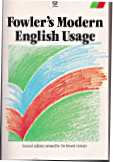

| Book of the Month | ||
 |
Fowler's Modern English Usage |  |
Publisher: Oxford Paperback
Authors: Revised by Sir Ernest Gowers
$25.95
ISBN 019 281389-7
After reading a battlefield report, Sir Winston Churchill wrote irritably to one of his senior generals about the misuse of language.'Read Fowler's Modern English Usage', Churchill recommended. This shows how much effect this book has had on the English language over the years. Since it was first published in 1926 this book has been reprinted many times to keep up with the ever-changing English language. The latest revision was in 2004, almost a century after Fowler started work on the original book. As an English-language textbook, Fowler's is one of the classics, found on bookshelves of language teachers and journalists everywhere. Even today, any discussion on the correct usage of a word comes to an end if a copy of Fowler is produced and the entry is checked. Sometimes only the inituals 'MEU' are all that are needed to send a student or journalist back to revise his work.
Although the book has notes on grammar and syntax, it is basically what would today be called 'A dictionary of misused words'. So from 'an' on page one to 'zz' (pronunciation of)on page 725 the dictionary goes through hundreds of words giving their correct usage and explaining why other usages are incorrect. One reason why this book has lasted so long is because of the author's obvious love of English and the humour and passion in his writing. For example he describes the use of 'okay' in business English as 'commercial barbarism', and talks of 'horrible' misuses of pronouns (such as saying 'someone has left their book' rather than 'his or her book'). However, the book also points out that some 'misusages' are actually older versions of English that travelled over the Atlantic with American colonists and now have been re-imported. 'Right' as 'very' is one such example, as in 'I'm right glad to see you'. There is no index, as the words are listed alphabetically, but sometimes word pairs that are confused are listed together, as with for example 'suspense/and suspension', with the text below explaining when the appropriate word should be used. There are no illustrations and the text is closely spaced and dense. This, together with the formal English of the writer and his fondness for using classical quotations to make a point means that students will sometimes struggle to understand the explanations. Nevertheless, the dense text is the price that has to be paid for keeping the book down to a handy paperback size that fits easily in a shoulderbag or rucksack. Many modern English textbooks have a tenth of the text and are twice the size. The book is also very poor at describing 21st century colloquialisms and 'taboo' words, possibly because the editors believe that these have no use in proper English in any case.
Who is this book for? As a reference work this book is useful to anyone who wants to make sure that a word has been used completely corerectly. It is also handy for those whose job it is to check the writing of others, such as editors or those who mark student exams. Those interested in English will find the book fun to dip into both for the author's lively language and for words which have somehow survived in the text but not in the 21st century. So we learn how to pronounce 'zingaro' in the book but Mr Fowler fails to tell us what a zingaro is. (A scruffy or untidy person who looks like a tramp.)
Verdict: A classic that's a bit out of date
Assessment 6/10